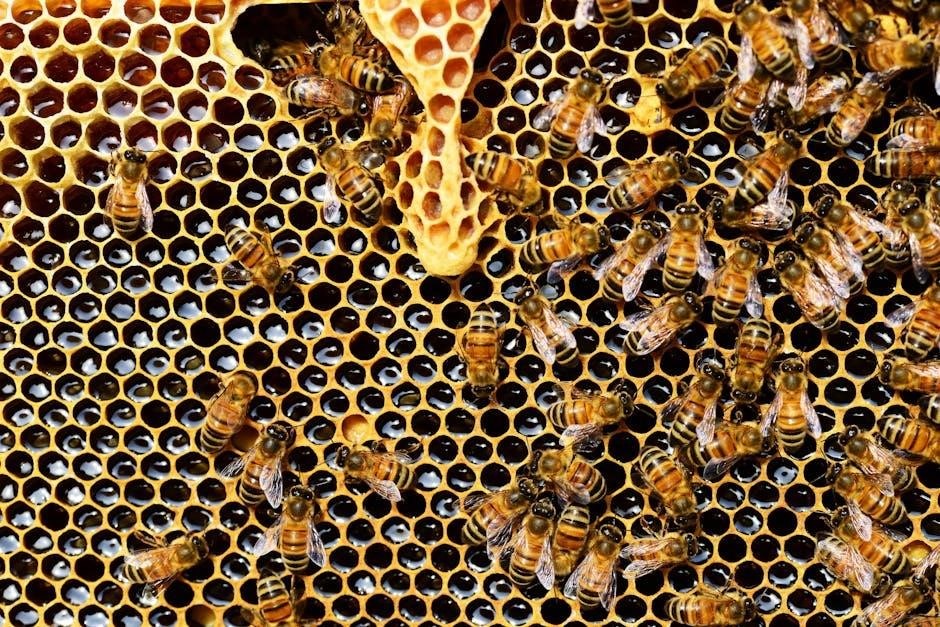Understanding the Swix Wax Temperature Guide is crucial for optimal ski performance. It helps select the right wax based on snow and air temperature, ensuring better glide and control.
Understanding Swix Wax and Its Importance
Swix wax is a critical component for skiers, enhancing glide, protection, and performance. It fills microscopic pores in the ski base, reducing friction and improving durability. Proper waxing ensures optimal interaction between the ski and snow, preventing suction and allowing smoother movement. The right wax hardness, determined by temperature, is essential for performance. Too soft, and it wears off quickly; too hard, and it doesn’t penetrate properly. Swix offers a range of waxes tailored to different conditions, making it a trusted choice among skiers. Regular waxing maintains ski health and ensures consistent performance across varying snow conditions; Understanding Swix wax is the first step in maximizing ski potential and enjoying a superior skiing experience.
Brief Overview of Ski Waxing
Ski waxing is a fundamental maintenance process that enhances ski performance by improving glide and protecting the base. It involves applying wax, allowing it to cool, and scraping off excess. Regular waxing prevents the ski base from drying out and ensures durability. Properly waxed skis interact better with snow, reducing friction and allowing smoother movement. This process is essential for maintaining optimal ski condition and performance across various snow conditions. By understanding and applying wax correctly, skiers can enjoy improved speed, control, and overall skiing experience. Regular waxing is a simple yet crucial step in ski care that directly impacts performance and longevity.

Importance of Temperature in Wax Selection
Temperature is crucial in selecting the right Swix wax, affecting its penetration, performance, and durability. Proper wax choice ensures optimal glide and control in various snow conditions, while incorrect temperatures can hinder performance.
How Snow Temperature Affects Wax Choice
Snow temperature significantly influences the choice of Swix wax, as different waxes are designed to perform optimally within specific temperature ranges. Colder snow requires harder waxes to maintain durability and glide, while warmer snow demands softer waxes for better traction and moisture adaptation. Measuring snow temperature accurately, typically within the top 1/4 inch of the snowpack, is essential for selecting the correct wax. If the wax is too hard for the snow temperature, it may not penetrate adequately, leading to poor glide. Conversely, a wax that’s too soft can degrade quickly, reducing performance. Swix waxes are formulated to match these conditions, ensuring skis glide smoothly and maintain consistent performance across varying snow temperatures. Proper wax selection based on snow temperature is vital for maximizing ski efficiency and longevity.
The Role of Air Temperature in Wax Application
Air temperature plays a critical role in the wax application process, affecting both the melting point and the adhesion of the wax to the ski base. For optimal results, the working area should be maintained at a consistent temperature between 40°F and 50°F (4°C to 10°C). If the air is too cold, the wax may not melt properly, leading to uneven coverage. Conversely, high temperatures can cause the wax to become too soft, making it difficult to apply evenly and potentially leading to a messy finish. Swix recommends using a thermometer to ensure the workspace is within the ideal range, as this promotes proper wax penetration and bonding with the ski’s base material. Maintaining the correct air temperature during application ensures a smooth, even layer of wax, which is essential for achieving the desired performance on the slopes.
Humidity and Its Impact on Wax Performance
Humidity significantly influences the performance of ski wax, as it affects the interaction between the wax and the snow. High humidity can lead to the formation of a thin layer of moisture on the snow’s surface, which interferes with the wax’s ability to create a hydrophobic (water-repelling) effect. This can result in reduced glide and increased friction, as the wax struggles to maintain a consistent bond with the snow. Swix waxes are formulated to perform optimally within specific humidity ranges, with colder waxes generally being more effective in high-humidity conditions due to their harder, more durable structure. Understanding and adapting to humidity levels ensures better wax adhesion and overall ski performance, making it a crucial factor in the waxing process. Proper wax selection based on humidity helps skiers maintain speed and control on the slopes.

Types of Swix Waxes Available
Swix offers a variety of waxes, including cold-weather, warm-weather, and universal options, each designed for specific snow conditions and temperatures to enhance ski performance and durability.
Cold Weather Waxes: Characteristics and Uses
Cold weather waxes are specifically designed for skiing in low-temperature conditions, typically below -10°C. These waxes are harder and more durable than warm-weather options, providing better glide and longevity on icy, dry snow. Their harder consistency reduces wear and tear, ensuring consistent performance over time. Cold waxes are ideal for race conditions or extended use in frigid environments, as they maintain their structure and provide optimal moisture repellency. Swix offers a range of cold-weather waxes, such as the iconic blue and green options, which cater to specific temperature ranges. Proper application ensures the wax penetrates deeply into the ski base, enhancing speed and control. Using the right cold wax is essential for maintaining ski performance and durability in harsh winter conditions.

Warm Weather Waxes: Features and Benefits
Warm weather waxes are designed for skiing in temperatures above -10°C, where snow is moist and sticky. These waxes are softer and more flexible than cold-weather options, allowing them to adhere well to wet snow and provide better glide in slushy conditions. Their ability to reduce suction between the ski base and snow enhances performance in warmer environments. Swix warm weather waxes, such as the yellow and red options, are ideal for spring skiing or racing in temperate climates. They also help fill minor scratches in the ski base, promoting smoother gliding. While they wear faster than cold waxes, their superior performance in wet conditions makes them essential for varying snow types. Proper application ensures optimal results, keeping skis fast and responsive in warmer temperatures.
Universal Waxes: Versatility and Application
Universal waxes are a practical choice for skiers seeking versatility across varying snow conditions. Designed to perform well in a broad temperature range, typically from -10°C to 10°C, these waxes offer a reliable option for everyday skiing. They are ideal for skiers who want to minimize wax changes or face unpredictable weather; Universal waxes provide a balance between durability and glide, making them suitable for both cold and warm snow conditions. Their ease of application and consistent performance make them a favorite among recreational skiers. While they may not excel in extreme temperatures, their adaptability ensures good results in most scenarios. Swix universal waxes are formulated to maintain ski base health and provide a smooth glide, making them a convenient and effective choice for skiers of all levels.

Application Techniques for Optimal Performance
Apply wax evenly, ensuring full coverage, then let it cool. Scrape off excess wax using a plastic scraper for a smooth finish and optimal ski base performance.
Preparing Skis for Waxing
Proper ski preparation is essential before applying Swix wax. Start by cleaning the ski base thoroughly using a nylon brush to remove old wax, dirt, and oxidized fibers. This ensures better wax penetration and adhesion. Next, structuring the base by lightly scraping or brushing helps create a textured surface for the wax to bond with, enhancing glide efficiency. Avoid using high temperatures that could damage the base material. For optimal results, ensure the ski is at room temperature before waxing. Finally, test a small area first to confirm the wax’s suitability. A well-prepared ski base guarantees even wax application and improved performance on the slopes.
Applying the Wax Evenly
Applying Swix wax evenly is critical for consistent performance. Begin by melting the wax using an iron set to the temperature recommended for the specific wax type. Hold the iron firmly and spread the melted wax across the ski base in smooth, overlapping strokes, ensuring full coverage from tip to tail. Pay special attention to the edges and high-wear areas. Avoid applying too much wax near the edges, as this will be scraped off later. Use a credit card or similar tool to spread the wax uniformly, ensuring it fills the base structure. Let the wax cool and harden completely before scraping. For best results, work in a well-ventilated area and avoid overheating the wax, as this can damage the ski base. Even application ensures optimal wax adhesion and performance on the snow.
Scraping Off Excess Wax
Scraping off excess wax is a crucial step to ensure optimal ski performance. Use a plastic scraper specifically designed for this purpose, as metal scrapers can damage the ski base. Hold the scraper firmly at a 45-degree angle and start scraping from the tip to the tail in smooth, even strokes. Apply moderate pressure to remove excess wax without gouging the base. Pay extra attention to the edges, where wax tends to accumulate. Scrape in one direction only to avoid spreading excess wax back onto the base. After scraping, use a cloth or paper towel to wipe away any remaining wax residue. For best results, let the wax cool and harden completely before scraping. Avoid using excessive force, as this can damage the ski base or remove too much wax. Proper scraping ensures a smooth, even layer of wax remains, providing consistent glide and control on the snow. Always store the scraper clean and dry to prevent wax buildup;

Maintenance and Care of Waxed Skis
Proper maintenance ensures wax longevity and ski performance. Store skis in a dry, cool place, away from direct sunlight to prevent wax degradation. Regular cleaning and edge checks are essential for optimal glide and durability, maintaining the integrity of the wax application and the ski base. Avoid exposing skis to extreme temperatures or moisture, which can affect wax adhesion and ski condition. Regularly inspect for damage or wear, addressing issues promptly to prevent further deterioration. Proper care extends the life of both the skis and the wax, ensuring consistent performance across various snow conditions. Always handle skis with care to avoid scratches or impacts that could compromise the base and wax layer.
Storage Tips for Waxed Skis
Proper storage is essential to maintain the performance and longevity of waxed skis. Store skis in a cool, dry place, ideally between 40°F and 50°F (4°C to 10°C), to prevent wax degradation. Avoid direct sunlight, as it can soften the wax and cause it to degrade. Keep skis away from humid environments, as moisture can damage the base and affect wax adhesion. Clean the skis thoroughly before storage to remove dirt and debris that might oxidize the base. Use a breathable ski bag or cover to protect against dust and pests. Never store skis in a damp basement or garage, as high humidity can compromise the wax and base structure. For extended storage, apply a thin layer of universal wax to protect the base from drying out. Regularly inspect stored skis for signs of damage or wax wear, addressing issues promptly to ensure optimal performance when skiing resumes.
Regular Base Preparation
Regular base preparation is vital for maintaining the performance and health of your skis. Start by brushing the ski base to remove old wax, dirt, and oxidized fibers, ensuring the surface is clean and even. Use a brass or nylon brush for this process, as it effectively opens up the base structure for better wax absorption. After brushing, apply a fresh layer of wax suitable for the current snow conditions, using an iron to evenly distribute it. Allow the wax to cool and harden before scraping off the excess with a plastic scraper. Pay special attention to the edges, ensuring no wax builds up in these areas; For deeper cleaning, periodic use of a base cleaner can help remove stubborn contaminants. Regular preparation not only enhances glide but also prevents the base from drying out, ensuring your skis remain in optimal condition for every outing.
Edge Maintenance for Better Glide
Proper edge maintenance is essential for ensuring optimal glide and control on the slopes. Sharp, well-maintained edges provide better grip on icy surfaces and improve overall skiing performance. Begin by cleaning the edges with a solvent to remove dirt and old wax residue. Use a diamond stone or edge file to sharpen the edges, maintaining the recommended angle for your skiing style. After sharpening, polish the edges with a fine-grit stone to remove any burrs or rough spots. Regularly inspecting and maintaining your edges prevents rust and ensures consistent performance. Additionally, avoid applying wax too close to the edges, as it can interfere with their function. By keeping your edges clean, sharp, and well-maintained, you enhance both speed and control, making every ski session more enjoyable and effective.

Future of Swix Wax Technology
Swix continues to innovate, focusing on eco-friendly waxes and advanced formulas. Research and development prioritize sustainability and performance, ensuring skis glide effortlessly in varying conditions while reducing environmental impact.

Innovations in Wax Formulas
Swix is at the forefront of wax formula innovation, continually refining their products to meet the demands of modern skiing. Recent advancements include the development of eco-friendly waxes that maintain high performance while reducing environmental impact. These formulas incorporate sustainable materials without compromising on durability or glide. Additionally, Swix has introduced temperature-specific waxes with enhanced molecular structures, allowing for better penetration into the ski base and improved adhesion. This means skis stay waxed longer, even in challenging conditions. The company also experiments with hybrid waxes that combine the benefits of different temperature ranges, offering versatility for skiers who encounter varying snow conditions. These innovations ensure that Swix remains a leader in the ski wax industry, providing solutions that cater to both competitive athletes and recreational skiers.
Eco-Friendly Wax Options
Swix has made significant strides in developing eco-friendly wax options, catering to the growing demand for sustainable skiing products. These waxes are formulated with environmentally responsible materials, reducing their ecological footprint while maintaining high performance. By incorporating natural ingredients and biodegradable components, Swix ensures that skiers can enjoy superior glide and durability without harming the planet. Eco-friendly waxes are also designed to be free from toxic chemicals, making them safer for both the user and the environment. Additionally, Swix offers recyclable packaging for these products, further emphasizing their commitment to sustainability. These options are particularly popular among environmentally conscious skiers who prioritize eco-responsibility without compromising on wax quality. Swix’s eco-friendly waxes are a testament to their dedication to innovation and environmental stewardship, ensuring that skiers can enjoy their sport while contributing to a greener future.
Emerging Trends in Ski Waxing
The world of ski waxing is evolving rapidly, with new trends emerging to enhance performance and sustainability. One notable trend is the development of hybrid waxes that combine the benefits of cold and warm weather waxes, offering versatility across varying snow conditions. Additionally, there is a growing interest in plant-based waxes, which are biodegradable and free from harmful chemicals. These eco-conscious options are gaining popularity among environmentally aware skiers. Another trend is the integration of nanotechnology into wax formulations, which improves durability and reduces the need for frequent applications. Furthermore, digital tools and apps are becoming increasingly popular, helping skiers determine the optimal wax based on real-time weather and snow conditions. These advancements not only simplify the waxing process but also ensure better results, making skiing more accessible and enjoyable for all skill levels. As technology progresses, expect even more innovative solutions to emerge in the field of ski waxing.
Mastering the Swix Wax Temperature Guide ensures optimal ski performance by matching wax to snow conditions, enhancing glide, and prolonging equipment life for a superior skiing experience.

Final Thoughts on Effective Waxing

Effective waxing is a cornerstone of optimal ski performance, and the Swix Wax Temperature Guide provides a clear roadmap for achieving the best results. By aligning wax selection with snow and air conditions, skiers can maximize glide, control, and durability. Proper application and maintenance routines ensure the wax adheres well and performs consistently. While universal waxes offer convenience, specific temperature ranges often yield better outcomes. Innovations in eco-friendly waxes and advanced formulas are reshaping the future of ski care, offering sustainable options without compromising performance. Regular base preparation and edge maintenance further enhance the skiing experience. Ultimately, understanding and applying these principles ensures skis perform at their best, whether on icy slopes or soft, wet snow. Investing time in proper waxing techniques pays off in improved speed, control, and longevity of equipment.
